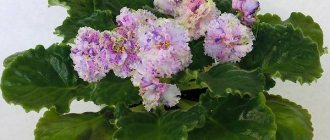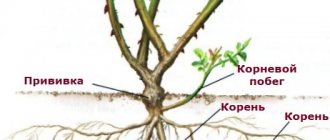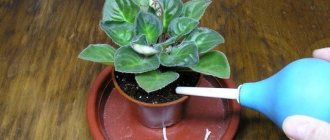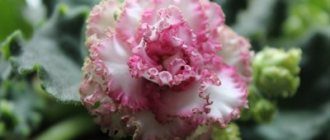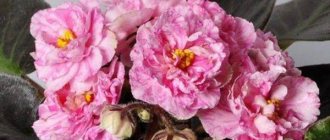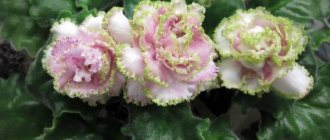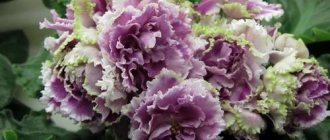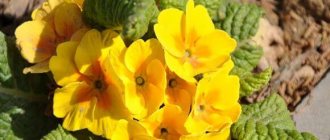Types of homemade violets
There are over 30 thousand varieties of Saintpaulia, which can be grown on a windowsill. These varieties fit into 5 main types:
- star: petals are the same size and spaced evenly in the center;
- bowl: the flower has the shape of a bowl, the petals are not fused at the base;
- bell: the flower looks like a bell, the petals are fused at the base;
- pansies: petals are arranged in two rows: 2 at the top and 3 at the bottom, the upper petals are smaller in size than the lower ones;
- wasp: 5 petals are divided: 2 upper ones are rolled into a tube, 3 lower ones hang freely.
It is also customary to distinguish between variegated violets - with brightly colored leaves and double flowers, collection violets - with large buds and wavy petals, and industrial violets - easy-to-grow Saintpaulias.
Saintpaulia varieties with names
Among the tens of thousands of varieties of homemade violets, the most popular can be identified.
Goddess of beauty
It is distinguished by a large double flower with bright crimson petals that shimmer with purple. The foliage of the Goddess of Beauty is dark green and flat in shape. The variety was developed by breeder E. Korshunova.
Black Pearl
This is another variety bred by E. Korshunova. A distinctive feature is velvety, dark purple flowers. Saintpaulia of this variety creates an inflorescence in the form of a cap, which can have up to 8 corollas. One flower reaches 7 cm at its peak. The rosette of the Black Pearl is simple, made of dark green foliage.
Pauline Viardot
Description of the variety: the wine color of this violet with a white border makes it perhaps the most noble representative of the entire family. The vertical arrangement of flowers adds solemnity. The rosette of this Saintpaulia is compact and the flower is large in size. Created by Polina Viardot E. Lebetskaya.
Beautiful Creole
And again a variety from breeder E. Lebetskaya. The beauty of Creole lies in its simplicity. The rosette of this violet is small and compact. At the same time, the buds are also small, the diameter of one does not exceed 5 cm. The advantage of the variety is that it has a lot of flowers, and they are all a beautiful dark blue color, bordered by a white edging.
These are not all the best varieties of Saintpaulia. The variety of these easy-to-care-for houseplants is amazing. It is no coincidence that many flower growers collect a whole collection of bright, multifaceted violets in their home.
Caring for them does not require much effort; even a novice gardener can grow them.
Violet has a huge number of varieties bred for growing at home.
Selection
This unusual luxurious variety was bred by one of the most famous domestic violet breeders, E. Lebetskaya. This specialist lives in Ukraine. The Wind Rose violet was also obtained there. Like all varieties bred by Elena Lebetskaya, this one has the prefix Le in its name.
All violets obtained by this specialist, including the Wind Rose, are extremely popular not only in Russia and Ukraine, but also in other neighboring countries.
When and how does it bloom
How it blooms
The flowering period for small violets begins earlier than for standard species: 5-6 months after planting, the young cuttings will bloom. Despite their small size, their flower stalks are strong, form large flower caps and do not fall on the leaves.
The onset of the flowering period can be accelerated if you increase the daylight hours and lighting intensity for the babies, feed them with fertilizer with phosphorus, and trim the stepsons.
Appearance, shape and color of flowers
Since there are many small varieties of Saintpaulia, the appearance of their flowers varies greatly. The petals can be smooth or double, the flower shape can resemble a bell or a star. There are usually several flowers on one peduncle.
The color range of petals is also quite wide. It is interesting that the petals are monochromatic, sometimes they have one shade or another. The most common colors of mini Saintpaulias are white, white with a lilac shade, pink, pure blue or blue with a purple tint, red-burgundy, blue.
After the flowering period ends, seed pods form on the peduncle.
When they bloom (using the example of popular varieties)
If optimal conditions are created for mini, their flowering period will last from 9 to 12 months. It is noteworthy that the flowering period is not related to the time of year - the little ones bloom both in summer and winter. However, most varieties begin flowering in early spring.
Changes in care during the flowering period
During the flowering period, the babies are cared for in the same way as during the dormant period: they are watered and the necessary air humidity is maintained. You just need to remember that pests and diseases are not treated during the flowering period.
In addition, a characteristic feature of small species is that during the flowering period they have many stepsons that need to be pruned in order to prolong flowering and prevent the transition to the standard.
Features of flowering, growth and reproduction
The varieties grow quite quickly, but the first flowering can be expected in about a year . The rosette forms independently, and even on window sills produces a fairly even and symmetrical bush.
Reproduction of this Saintpaulia is not particularly difficult, because there are no external factors that would exclude some methods.
The plant blooms profusely , regardless of conditions. The flower stalks are quite thick, smooth and raised above the foliage, forming a beautiful cap, almost every flowering.
Attention! In the Winter Rose variety, there is a tendency for flower stalks to fall on the leaves, but this process is not regular.
The buds last a very long time. It may take two weeks from full bloom to drying of the flower , but this is average.
Depending on the temperature, the color may change slightly :
- In cool conditions, the contrast between the main tone and the back of the petals is much brighter;
- And in the heat the inside becomes darker.
About the color scheme of blooming violets
Indoor violet comes in a wide variety of colors and shades - from white to red, from blue to purple. The blue violet looks especially beautiful. In addition to the varied colors, Saintpaulia varieties differ in the shape of the inflorescences and the degree of terry. There are semi-double and double varieties of violets. The leaves can also please the owner with different shapes and colors (from light green to dark green).
Lilac Saintpaulia in a pot
Breeders managed to obtain such a variety of species and varieties as a result of crossings and as a result of the natural process of mutation.
This is interesting: thanks to many years of work, breeders have managed to develop violets of unimaginable two-color, multi-color and fancy shades.
At the moment, Saintpaulia has a wide variety of varieties. There are varieties of violets with stains, spots, patterns, stripes, inclusions and contrasting edges.
Various Saintpaulias on the windowsill
Transfer
Keeping the Windrose violet in the same pot for too long is undesirable. After all, even constant fertilizing does not save the soil in a container with any flower from depletion. The Wind Rose should be replanted if:
- a white coating has become noticeable on the surface of the soil in the pot;
- the plant looks depressed, its leaves die off, and fertilizing does not help.
Windrose violets are transshipped using conventional technology. That is, take a larger pot, pour expanded clay and a soil mixture intended for growing violets into it (a little). Next, place the flower itself in the pot and fill it with the remaining soil.
All rotten roots should be removed during the transshipment process. Peduncles are removed several days before this procedure. After the root collar of the Wind Rose is covered, the soil in the pot should be slightly compacted and watered.
Top ten most popular varieties
The most common, both among experienced flower growers and novice collectors, are:
- The bride's bouquet;
- White Sun of the Desert;
- White mustang;
- White Nights;
- White magic;
- Lady in White;
- Juliet;
- Cotton candy;
- White angel;
- Your Mightiness.
The bride's bouquet
Saintpaulia Bride's Bouquet from the famous breeder Konstantin Morev blooms with large snow-white flowers with wavy petals, and the cream-colored core gives the plant a pearly shine, creating an atmosphere of solemnity.
White Sun of the Desert
The White Sun of the Desert variety blooms with snow-white, smooth, medium-sized flowers that most closely resemble wildflowers.
White mustang
The variety called White Mustang looks no less exotic. A velvet fan-shaped flower with a yellow core and blue splashes in the design of dark green leaves looks unusually delicate.
White Nights
Large light blue semi-double stars with a fantasy color. It is this spectacular flower that is called White Nights, and therefore the plant is classified as a subgroup of white violets. The rosette of Saintpaulia consists of several tiers of dark green, velvety leaves, pointed at the edge.
White magic
The White Magic variety is one of the most spectacular terry Saintpaulias, decorated with fringe. Monochrome – bright white. The rosette is variegated green with whitish veins.
Lady in White
Another unusual type of white palette is Lady in White. Huge, up to 8 centimeters in diameter, double snow-white stars, with petals wavy at the edges. The rosette is small, neat, light green.
Juliet
In addition to plain snow-white violets, varieties with colored inclusions are also extremely popular. Such beauties include, in particular, the Juliet variety.
Large terry stars are white with pink and lilac splashes; their appearance resembles the color of a fantasy. The petals are corrugated, with a fan-shaped edge.
Cotton candy
The peculiarity of the Cotton Candy variety is the abundant flowering of snow-white, voluminous, densely double roses, with corrugated edges of the petals. The rosette consists of wavy, toothed, medium green leaves.
White angel
This sport is somewhat different from other varieties of white. Smooth, light, blue-tinged star-shaped flowers in a rosette design consisting of dark green round leaves.
Your Mightiness
The variety Your Grace is a profusely blooming snow-white rose with fan-shaped double petals and a comb type of flowering. The abundance of dark green leaves makes the flower even more spectacular. This flower will be the highlight of any collection, even for the most experienced and spoiled gardeners.
Popular varieties of violets
There are different varieties of Saintpaulias, which vary in size, shape, number and shade of petals.
Viola with pink flowers
Pink violet can be either double or semi-double, with or without edging.
This is a profusely flowering, very beautiful variety. Pink double violet boasts large flowers. Lilac specks are visible along the edges. The petals are wavy and have a light green edging at the edges.
Medium size - no more than four centimeters in diameter, double, in appearance very similar to lush garden roses. Viola petals are white and pink in color. The edges are broken, corrugated, and come in both light and dark pink.
The variety has large double corollas and bright pink flowers that look like a miniature rose.
Violets with purple flowers
Viola violet comes with or without edging of various colors. There are semi-double, terry or simple options.
It has large purple-plum single or semi-double flowers. The edging is bronze-green, wide, and strongly wavy.
With purple flowers
Violas with burgundy flowers
Burgundy violet comes with semi-double flowers, with or without edging.
Semi-double plants of a burgundy-violet hue. The edges of the petals have a bright white edge. In natural light it turns purple, almost black.
Semi-double velvety, large flowers. The color is deep, light burgundy.
With burgundy flowers
Violets with green border
The violet violet with a green border looks very beautiful. The flowers are large, semi-double and double.
The flowers are semi-double, large and white. Imprints of purple are clearly visible on the petals. The edge is framed with green lace trim.
The flowers are large, semi-double and double. At the bud stage they are completely green. As the bud blooms, it enlarges and turns white. A wide green border remains along the edge of the lace petals.
With green border
Violets with white border
Such indoor plants look very beautiful, especially varieties in which the violets themselves are red.
Peduncles erect, powerful. The flowers look like pompoms - large, terry, wine-colored. The edge of the petals is decorated with a wide corrugated white frame.
It has large red-crimson velvety double or semi-double flowers. The edges are corrugated. The edging is thin and white. A white tint is clearly visible in the middle.
Violets with lilac border
South night
The variety has deep blue simple star-shaped flowers with light crimson fantasy polka dots and a thin lilac edge.
White violet with a purple border is characterized by semi-double and double white buds in the shape of stars.
With lilac border
There are quite a lot of varieties and varieties of indoor violets and every gardener can choose them according to his taste. Proper care will preserve the peculiarity of a particular variety, emphasizing its uniqueness and unusual beauty.
Characteristics. Saintpaulia “sport”
A distinctive feature of this variety is its ability to go into sports.
Sport is the difference between Saintpaulia and the mother plant (variety). The new plant has no varietal characteristics or they are barely noticeable.
It happens that the shape and color of the leaf is the same for both the variety and the sport. To see the difference you need to wait until flowering.
Often sports produce bright red or plain pink flowers, which also look impressive. When changing the sheet, the first thing that disappears is the waviness of the sheet.
If you collect varietal violets, pay attention to other spectacular varieties: “Raisin”, “Chimera”, “Dance of Galaxies” and “Frosty Cherry”.
What varieties are cultivated at home?
At home, simple violets of the industrial group, variegated and collection ones are grown. Beginners are advised to start simple violets to gain experience in caring for them. An experienced florist can already grow complex breeding varieties. A huge number of species are grown at home. Experts have developed about thirty-two thousand varieties of indoor Saintpaulias, differing in many parameters: color, shape, leaf structure and rosette.
About twenty species of Saintpaulia grow in the wild. In natural conditions there are:
Velvet Saintpaulia
Velvet Saintpaulia
On the front side, the leaves are painted green, and the back side has a reddish tint. The inflorescence is made up of purple flowers with a dark central part.
Violet flower Saintpaulia
Violet flower Saintpaulia
Short stems bear blue-violet flowers and rich green heart-shaped leaves. The diameter of the rosette can reach sixty centimeters.
Saintpaulia Grote
Saintpaulia Grote
Belongs to the ampelous varieties. The pubescent leaves take on a rounded shape. The lilac-blue flowers do not grow more than two and a half centimeters.
Types and varieties of violets
Those violets that regularly grow in parks and gardens are called African violets (Saintpaulia Ionatha). However, these plants are not actually a variety of classic violets, although they share the same flower shape.
What types of violets should I pay special attention to?
African violets owe their popularity to their wide range of colors. In the plant world, there are white, blue, pink, green, purple, etc. In addition, the petals may have white spots or edges. They can also be two-tone or multi-colored.
With border:
- Iceberg. It has quite remarkable star-shaped double inflorescences;
- Through the Looking Glass. Semi-double inflorescences of this variety have a border;
- Rose of Wind. The inflorescences of this violet are a bit like ordinary garden roses;
- Natalis Estravagante. Lace inflorescences with a multi-colored border;
- Beautiful Creole. The flowers of this variety are star-shaped;
- Modern Talking. The corollas of this violet are white, and the border is usually purple or blue;
- violet-flowered. The flower has heart-shaped rosettes, short stems and a large rosette.
Beautiful violets with a border
Burgundy:
- Goddess of beauty. The leaves are large and dark. Double flowers;
- The magic of love. This variety has double flowers;
- Black Prince. The flowers are double and resemble a star.
White:
- Alice Blizzard Baths. Alabaster flowers resemble stars and are quite modest in size. The petals are semi-double, the rosettes are bright and heart-shaped;
- Snow lace. Double flowers with a border and a blue spot in the middle;
- The bride's bouquet. Large milky flowers are star-shaped;
- The Snow Queen. Semi-double flowers of medium size, round rosettes.
Blue varieties of violets:
- Blue dragon. Large inflorescences have a light green border;
- Blue Danube. The inflorescences of this Saintpaulia reach 5 cm in diameter. There are small teeth at the ends of the leaves;
- Blue Lagoon. The inflorescences have a full border and a blue spot in the center.
Pink:
- Georgia. Large double inflorescences have a rich color and a thin border of light green;
- Marquise. This variety has a rich pink hue and a blue border;
- Magdalene. The inflorescences are large, double, and resemble a ball. The edging is wavy;
- another name for an unusual pink violet with a green border is Winter Smiling.
Purple:
- Currant dessert. The petals have a fringe of an unusual color. The leaves of this unpretentious plant are velvety;
- Winter rose. The shape of the inflorescences is very similar to rose flowers and has a white edge. The leaves are small and rich in color;
- Baltika. The variety is classified as semi-double and has a wide edge. Leaves with toothed tips;
- Rosemary. The inflorescences are double, star-shaped with bright white streaks. The leaves have serrated edges.
Lilac:
- Chanson. The flowers look like bells. The plant blooms for a long time;
- Zemfira. Flowers are single or semi-double. The leaves are colorful;
- Satellite. The rosette is small, and the flowers are brightly colored.
Note! Breeders have long tried to develop a variety with yellow flowers. In nature, Saintpaulias do not have a gene that would be responsible for this color
Only at the end of the 20th century. one breeder managed to get a yellow variety. No one knows his name.
How to preserve varietal violets
To ensure that your violet does not change in appearance after purchase and retains all varietal characteristics, follow simple rules
- Have you already tried propagating varietal violets?
- Try to maintain a constant temperature.
- Do not expose the plant to stress.
- Provide timely and quality care.
Not really
It is believed that violets that have simple colors are less prone to change.
Before purchasing “Wind Rose,” which makes you fall in love at first sight, study in detail the pros and cons of the variety.
Expert opinion
Pavlova Ekaterina Mikhailovna – agronomist, landscape designer
Participant of scientific conferences
When buying a scion or baby, be prepared to receive a plant that will be completely different from the mother one.
Also, do not forget that the Wind Rose has a large rosette. And if you admire flowers 2-3 times a year, then the rosette will be constantly before your eyes.
If Saintpaulias do not bloom at all, read the material at the link. It will be relevant for owners of most varietal Saintpaulias, for example, “Duchess” violets.
Therefore, when choosing flowers, first of all pay attention to the leaves.
Fantasy violets
“Ever since I fell in love with this flower, I have infected all my friends with this hobby,” says Galina. – And for almost 15 years now I have been happily communicating with this flower. And violets are very different, just like people. Each variety has its own disposition, its own character, its own preferences, and its own special beauty. At first I had 10 varieties, then 50, then 100, and off we go... At the moment, the collection includes more than three hundred varieties of violets, each better than the other. And I can't stop. I would like the collection to be replenished with new violets. And among them there is not one, beloved. Favorite – everyone! And let each variety have its own shape of flower petals and its own shape of leaves. And the palette of violets is so diverse that there is probably no color that is not present in these indoor flowers. That’s why I love them all!”
The natural growth area of the indoor violet or Saintpaulia (Saintpaulia - lat.) is small, this is East Africa. The largest number of plant species can be found in the Kenyan Usambara mountains, where Saintpaulias grow next to waterfalls and on the banks of mountain rivers.
Rose Day. Primrose
The flower received its name in honor of its discoverer, Baron Walter von Saint-Paul. Sometimes the plant is called Uzambara violet. By the middle of the twentieth century, this representative of the flora became one of the most popular indoor plants. Today, breeders have developed more than 32,000 varieties of this plant.
If the recognized beauty of flowers - the rose - is called the “queen of the garden”, then the violet is fully worthy of the title “queen of the windowsill”. I don’t know which indoor flower can surpass the violet in the number of varieties and beauty of flowers. No wonder the beauty of the violet is often compared to a rose. From Galina I found the following varieties: English Rose, Northern Rose, Shanghai Rose, Ice Rose, Green Rose...
Breeders compare violet with other flowers, but at the same time they still highlight its superiority in beauty, as can be seen from the names of the varieties: Magic Tulip, Divine Lotus, Wild Orchid, Bloody Orchid, Hydrangea...
The beauty of this flower is often compared to the shimmer of precious stones. In Galina’s collection I found varieties of violets: Ruby in Emerald, Mughal Ruby, Blue Diamond, Brazilian Topaz, Aquamarine...
Pink Watercolor
It seems to me that the violet is not only a living plant, it is a real living work! And it is not for nothing that it is given names associated with artistic art, with very delicate flowing watercolors. And with such a favorite art form for many as theater! Galina’s collection includes varieties: Pink Watercolor, Ballerina, Pink Ballet, Minuet, Fire Dance, Lviv Opera...
DarlingFairy
Many flower lovers simply adore violets. And flower breeders leave this tenderness and love for violets in the names of varieties. So they show off on Galina’s windowsill: Fairy, Sweet Fairy, Darling...
The image of the violet came to us from a small purple flower found in the forests of the middle zone. The stems of varietal violets are shortened, and the fleshy leaves, covered with thin fibers, are collected in a basal rosette. The color of the leaves can be either solid green or spotted. Violet flowers, which are collected in racemes, like the forest violet, have five petals. But the sizes of the flowers are much larger - from 2 to 5 cm, and the colors are very diverse - from white to dark purple.
The white tones of violets look very elegant and solemn. Their beauty is enhanced by the fullness of the petals; The wavy border curling along the edge of the petal gives the flower an extraordinary originality. And the tints of pale pink, blue, white-violet, and greenish colors turn the violet into a gorgeous flower. Of the white violets, I liked the varieties: Abigail, Amelie, Mass Glass, Pink Chablis, Envy of the Gods, Marcela, Artik Frost, Yvette, White Queen, Mischief, Winter's Tale. The white-pink-green variety Wuxi Pusi evoked special love and affection.
Green violets also look very unusual and attractive. From Galina I found such varieties as: Grinya, Beryl Frost, Ireland, Green Apples...
Arctic Frost. Chimera bloom
Experts distinguish the following types of violet/sainpaulia flower shapes: classic, star-shaped, fancy, edged, chimera. Of course, all these types of violets are present in Galina Leontyeva’s flowers. But I would call all her violets fantasy! There is too much variety in the shape of flowers, their design, color scheme and pattern. And, if we see on the petals of violets not only various strokes, dots, specks, but also large polka dots of a different color, then this causes delight and tenderness!
Secrets of cultivation
Ice rose loves diffused sunlight, preferring eastern or south-eastern window sills so that there is a lot of light, but direct sunlight does not leave burns on its leaves. On the northern side, with a clear lack of light, flowering will be more than modest. The only way out is to organize additional lighting. You need to choose a lamp with white cold light and place it at a height of 20 cm above the plant. The same thing will have to be done in winter if you want to admire the blooms all year round, because if there is a lack of light, the violet will not please you with flowers.
Violets feel normal at temperatures from +16 to +28 degrees, but to bloom they need a range from +20 to +26 degrees. When the air temperature is too low, they stop growing, and in extreme heat they begin to dry out or wither.
Plants should be watered as needed, when the top third of the soil dries out. The frequency of watering depends on the time of year, air temperature, age of the violets, and the size of the pot, so it is better to check the condition of the soil. For irrigation, use only soft, clean water no cooler than the air, maybe even a couple of degrees warmer.
For comfortable growth of Saintpaulia, an air humidity of at least 50–60% is needed. In extreme heat or when heating devices are on, the humidity around the plant is increased using a tray with wet pebbles or moss, on which a pot with a stand is placed. You can simply hang a wet towel on a nearby central heating radiator or spray the air around the flower so that the droplets do not fall on it.
The Ice Rose is replanted after 2 years using the transshipment method, being careful not to damage the roots. The pot can be made of any material, its size is important. If it is too large, the roots will grow intensively, but the violet will not bloom, and there will always be a risk of soil acidification. If the roots hit the walls and entwine the entire earthen ball, they won’t like it either. Usually the pot is chosen so that the leaves, after planting, extend half beyond its boundaries.
The soil should be slightly acidic, fertile and breathable. You can buy a universal one, and then add soil from under coniferous trees, coconut fiber or sphagnum moss, and crushed pine bark to it. You can buy soil for violets, but add more vermiculite to it for greater looseness.
Ice Rose responds well to feeding with Kemira Lux, but it needs to be diluted twice as much as indicated in the instructions.
Is it possible to keep her at home
Violets are often seen in gardens. These are small, but quite profusely flowering plants. The flowers on them are located in the middle of the rosette with a cap. You can grow them not only outside (where, by the way, they survive only one summer season). Saintpaulias have long earned people's love; they have been grown for a long time as potted indoor crops.
Planting and caring for Uzambara violet at home requires compliance with a number of certain conditions.
Important! Particular attention should be paid to the difference between real violets and Saintpaulias. The first are representatives of the Violet family, perennials that can overwinter outside. The second ones are plants of the Gesneriev genus similar to the first ones.
Both flowers are called violets because they are similar, but they are also different.
The second are plants of the Gesneriev genus, similar to the first. Both flowers are called violet because of their similarity, but at the same time they are different.
LE-Northern Rose
| Exhibition in the Violet House, March 2013 I bring to your attention a photo report from the exhibition dedicated to the MARCH 8 HOLIDAY “Give women flowers” - 2013, which took place from March 1 to 11 in the Moscow Violet House.. |
Flowers by train!
ATTENTION! Sending by train is possible to all cities if there is a direct connection from Tyumen to your city! Year-round delivery of orders to the cities: Astrakhan, Baku, Vladivostok, Vladimir, Volgograd, Vyazma, Ekaterinburg, Irkutsk, Ishim, Kazan, Kamensk-Uralsky, Kemerovo, Kirov, Krasnoyarsk, Makhachkala, Megion, Miass, Minsk, Moscow, Nizhnevartovsk, Nizhny Novgorod , Novosibirsk, Omsk, Penza, Pervouralsk, Perm, Rostov, Samara, St. Petersburg, Saratov, Smolensk, Sochi, Surgut, Syzran, Tobolsk, Tomsk, Ulan-Ude, Ulyanovsk, Ufa, Khabarovsk, Chapaevsk, Chelyabinsk, Chita.
| https://vk.com/fialki_sibir_ural |
| SPECIAL OFFER from 01/08/2018 Please keep track of the sale of children, starters, divisions, adult violet plants and pelargonium cuttings |
| Alyona! Thank you very much for receiving the long-awaited parcel. Everything was packed very... Nelly June 13, 2022, 21:09 // Guest book – Good luck in growing. Alena February 06, 2022, 21:48 // Guest book – I want to say a big thank you to Alena for the wonderful children. All so beautiful, juicy and strong. Svetlana February 06, 2022, 12:32 // Guest book – Of course you can, email the list. Alena July 26, 2022, 08:15 // Contacts – Flower Paradise Thank you, Lyudmila! Good luck in growing. Alena July 26, 2022, 08:15 // Guest book – |
Violet RM-Lady Rose
Feminine violet Lady Rose.
The most delicate Saintpaulia of the standard type has been appearing at exhibitions since 2014. For the RM-Lady Rose violet, you can read the photo and description below.
Presentation of special touches
The violet independently begins to arrange the leaf plates that replenish the rosette according to the planned number of floors - tiers, necessary for its decorative appeal, while maintaining a neat order.
The gradually formed bush of a compact configuration, as in architectural practice, displays a magnificent pattern of mosaic alternation of leaves, where each section can receive an optimal charge of solar energy for power.
Wide - oval medium-sized violet leaves have:
- Dense structure;
- Coarsely cut teeth along a slightly wavy contour;
- Configuration in the form of a small boat or a sail curved towards the center;
- Smooth surface with pimples;
- And dark tonal coloring.
Gorgeous violet caps consist of large terry flowers with full petals. The coloring of the corollas is based on warm shades of the pink palette, which smoothly flow into a delicate light green color on the edges ending in a thick corrugated edging.
The petals themselves are different:
- Dense texture;
- And thin translucent veins running across the entire surface from top to bottom.
Sports
The violet occasionally sports, forming flowers of a pinkish-beige color with an extremely thick corrugation of an intense light green-emerald hue along the contour.
Occasionally, sports are found in this variety.
Difficulty of cultivation in collections
The variety is quite easy to care for and has only favorable features:
- It creates a tight socket itself;
- Loves to bloom luxuriantly and often;
- The size of the flower caps is constantly increasing.
CAREFULLY! Violet requires a large amount of intense lighting, so specimens of the variety should not be deprived of additional light from diffuse spectrum lamps - they are responsible for the size of the flowers and the brightness of the color, and also help maintain the stable density of the edging ruffle.
The Saintpaulia in question blooms profusely.
Violets similar to roses: varieties
The popularity of violet varieties, whose flowers are more magnificent than usual with numerous double petals, is only growing. Large-flowered Saintpaulias are varieties whose corolla diameter exceeds 7 cm. Among the most spectacular new products that have managed to go on wide sale, it is worth noting:
Magic of Love - unusual violets with densely double flowers of a beet-red hue with a white border along the edge of the petals. The leaf is large emerald green. Peduncles bear 2 buds.
Magic of Love
Zephyr - a variety bred by breeder K.L. Morev. Cup-shaped large star-shaped flower with double petals. A light pink base shade with darker pink spots in the center as the bud finally opens and becomes more saturated. The leaf is light green, evenly colored, slightly gathered along the edge, like ruffles.
Marshmallow
Ming Dynasty – variety bred by breeder I. Fredette. Its cupped pink flowers have a heavily ruffled petal edge. Almost white in the center towards the edges they acquire a soft pink tone. The leaf is also corrugated and combines several shades of green in the form of specks and spots.
Ming Dynasty
Yesenia (Le Esenia) is a variety bred by Vinnitsa breeder Elena Lebetskaya. Large purple-white terry corollas with a diameter of up to 5 cm can simultaneously bloom in quantities of up to 40 pieces.
On a note! The flowering period is from September to March.
Yesenia
TZ-Sunset - violet by K. Morev. Pink-red large semi-double flower with a darker center. There are 1-2 buds on the peduncles. The leaf is large and shiny with a slightly serrated edge.
TZ-Sunset
Briefly about the history of the emergence of new varieties
In Russia, Ukraine, Belarus, European countries, and the USA, there are many nurseries, as well as private breeders, whose specialization is varietal violets. It happens that the same trade name may belong to plants that are outwardly different in description. Therefore, it is not surprising that under the name Winter Rose you can see completely different flowers in various catalogs. For example, Elena Korshunova, a well-known breeder in Togliatti, registered her variety “Winter Rose”.
Winter Rose by Elena Korshunova
Prefixes to the name indicate which nursery or breeder managed to obtain this flower for the first time. So, RM - an indication of the breeder Natalya Skornyakova, ND - Natalya Danilova-Suvorova, 23 - Yana Zubo, etc.
The process of introducing new products is very exciting, although not fast. There is no guarantee of success, but there is always a chance to grow varieties with unique characteristics.
Interesting! When crossing blue and purple violets, you can get a new flower with petals of two shades at once.
For crossing, two adult plants in the flowering stage are needed. Pollen ripens 5 days after the bud opens. It is carefully transferred to the pistil of the crossed flower. If pollination is successful, a seed box will form from the wilted corolla. They are so small that they look like dust. They ripen within 6 months. The dried peduncle with the capsule is cut off, carefully opened and the seeds are dried for another 3 weeks. Then sowing is carried out. Seed germination lasts only 6 months. This is how rare violets are obtained, as well as varieties of violets with the largest flowers.
Leaf cuttings of ordinary Saintpaulias will produce plants that are 100% identical to the mother ones. But not chimera varieties. They do not reproduce by leaves while retaining maternal characteristics; new violets will produce buds of unpredictable colors.
Reproduction
Saintpaulia LE-Rose of the Winds is propagated by rooting leaves or by pinching. The separation of stepchild rosettes from the parent individual is carried out during the transplantation process, using a stationery knife or blade. The rosette is rooted in peat tablets, and transplanted into permanent pots after the leaves have grown to 5 cm. This method is the most preferable, as it allows the varietal characteristics to be preserved.
Propagation of Saintpaulia using leaf cuttings is carried out as follows:
- a strong and healthy leaf is selected from the bottom or middle row and separated from the parent;
- Make an oblique cut on the cutting and place the leaf in boiled water;
- if a soil mixture or peat tablet is available, then the leaf is immediately placed there;
- 4 weeks after planting, the cutting usually grows 4 cm, after which the young shoot can be transplanted to a permanent place.
The first flowers on such a plant appear after about a year.
Thus, with proper and attentive care, it is quite possible to preserve the varietal characteristics of the LE-Rose of the Winds violet. To do this, you just need to carefully follow the recommendations and give the flower a little more time and attention.
Video review of the sport from violet LE-Rose of the Winds, see below.
How to care
Let's get acquainted with the main points of caring for the ice rose violet.
Watering
It is necessary to moisten Saintpaulia only with clean, soft water at room temperature (+20-25 degrees). Cold water is not suitable for irrigation, as it often leads to rotting of the plant roots.
Watering can be done both on the ground and through a tray. The second option involves immersing the pot in water: in this way, the roots are quickly saturated through the drainage holes. After watering through the tray, be sure to place the pot so that water can drain from the drainage holes.
When watering the plant in the usual way, remember that you cannot wet the violet rosette with water. Make sure that water does not get deep into the rosette, as this can quickly cause rotting of the plant stems. And when moisture gets on the foliage, unsightly whitish spots can form.
In the warm season, the ice rose needs watering more often than in winter. You can determine whether it is worth watering by the condition of the top layer of soil: if it has dried out by one and a half centimeters, it is time for the next moistening procedure.
Top dressing
As already mentioned, after planting the violet does not need to be fed for some time: this time can stretch from 2 to 6 months in some cases. Then feeding will be necessary.
In the spring, nitrogen must be added, since this mineral is necessary for the growth of lush green mass. During and after flowering, the plant needs potassium, but you can temporarily “give up” with nitrogen. As a top dressing, use ready-made mineral compositions sold in every flower shop.
If the plant “does not want” to bloom or produces single and frail buds, most likely it does not have enough phosphorus. To solve the problem, add phosphate fertilizer to the soil.
It is not recommended to fertilize:
- in the first few months (at least two) after planting/transplantation;
- with sudden changes in room temperature;
- when keeping the plant in direct sun.
Frequency of fertilization: at least once a month if you want to get a lush flowering plant. The following schedule is optimal:
- fertilizing with nitrogen for the first time in spring;
- after 2 weeks, fertilizing with nitrogen and potassium;
- Every 1.5-2 weeks, potassium phosphate fertilizer is applied until the flower enters the dormant period.
It is recommended to apply fertilizers in liquid form, combining the procedure with watering.
Transfer
A violet that is already a year old or more should be replanted no more than once every two years. The procedure is carried out using the transshipment method in order to preserve the roots of the plant as best as possible.
When old violets are replanted, more work will be needed. In plants, the outer leaves are usually cut off, leaving only the middle. Then the rosette is cut off and placed in water for roots to grow. This procedure rejuvenates the rosette.
Reproduction
Ice rose violet reproduces vegetatively - by leaves. Planting material is rooted either in water or directly in the soil.
A leaf with a petiole is cut only from an adult plant: a specimen is taken from the second rosette row. Most gardeners wait for the roots to appear by dipping the petiole of a leaf into a glass of water. After the roots appear, the leaf is planted in the ground.
You can immediately bury the petiole in the ground. The depth of penetration in this case is 1.5-2 cm. Before planting, make sure that the soil is sufficiently loose and nutritious and contains vermiculite or perlite. The first time after placing it in the ground, the petiole must be kept in greenhouse conditions. To do this, put a transparent plastic bag on top of the pot - a kind of mini-greenhouse.
Diseases and pests
Like any plant, violet is also susceptible to various diseases. Among them, it is worth noting the most common ones.
- Late blight. This disease most often occurs due to too much humidity. To prevent this, it is necessary to ventilate the room more often, and also follow all watering rules.
- Powdery mildew. This disease is determined by the presence of small white spots that appear on the top of the leaf. This happens when the temperature changes too sharply, as well as from too much moisture.
- Gray rot. Most often it appears at low temperatures or with excessive moisture.
If we talk about pests, these can be parasites such as aphids or spider mites. The fight against them can be carried out both with the help of special preparations and traditional methods.
To summarize, we can say that breeding green violets is an interesting, but rather labor-intensive business. To grow such plants, you must pay attention to them, only then will they be able to please you and your household with beautiful and delicate flowers.
For a review of the green violet “RS Green Corals”, see the following video.
Tips for beginning gardeners
Large exhibition varieties are considered the most capricious to grow; their maintenance has its own difficulties and is not recommended for beginners. Avoid them if you don't have enough experience.
The most suitable option for the first violet is the ampelous or mini variety. And even in this case, it would not be amiss to study information about the content of these plants:
- In variegated violets, when there is a lack of light, the leaves usually turn pale, but direct sunlight is also harmful - they leave marks in the form of burns. And such varieties are not propagated by leaf cuttings; in this case, a peduncle is used for rooting;
- A small pot is well suited for violets, because they bloom after the roots fill the entire volume;
- A bush with too much foliage may stop blooming, so it is helpful to prune it regularly.
Important! Some violets sometimes experience a loss of varietal characteristics. For example, in a fancy flower the spots disappear, and the flowers lose their borders and become uniform in color
This phenomenon is called “sport” and the reverse process will not happen. To preserve the variety, propagation by stepsons or daughter rosettes is recommended.
Growing conditions
“Ice Rose” requires fertile, loose soil that easily allows air to pass through but retains moisture. An excellent solution would be to purchase a ready-made mixture in a store, enriched with all the necessary substances.
You can make the mixture yourself. In this case, it is worth taking chernozem soil and peat from the upper layers, vermiculite, coconut fiber and charcoal. It is better to collect chernozem in a pine forest, and then be sure to calcinate it in the oven for 60 minutes. The soil must be forest soil, since soil from garden beds is not suitable for Saintpaulia. The acidity of the mixture should be medium (from 5 to 5.5 pH).
The size of the pot should match the size of the rosette. If it turns out to be too large, the root system will grow abundantly and the likelihood of flowers appearing will decrease. The optimal container size will allow you to both fill the soil with roots and stimulate active flowering. To determine the appropriate parameter, it is worth measuring the diameter of the outlet and dividing it by three.
In general, for adult flowers it is recommended to select containers with dimensions of 9x9 centimeters, and for young flowers - 5x5 or 7x7 centimeters.
Lighting is extremely important for Saintpaulia. In the warm season, ordinary light from the street is enough
In other months, the gardener will have to use both regular fluorescent lamps and special phytolamps. The window on the windowsill of which the “Ice Rose” will be placed should look either northeast or northwest. If you leave the violet on the south side, then direct sunlight can burn the leaves of the plant and the flowers will dry out.
The humidity level should exceed 50%, as violets do not tolerate dry air well. In winter, the Ice Rose, placed next to a working battery, requires additional care. For example, you can place a glass of chilled water nearby or purchase a special electronic humidifier for the room. Despite the “telling” name, the variety does not tolerate cold as well as heat. He prefers room temperature, which is about 20 degrees Celsius (acceptable limits are from 18 to 24 degrees Celsius).
Too high a temperature leads to a halt in development, and too low a temperature that threatens the root system.
